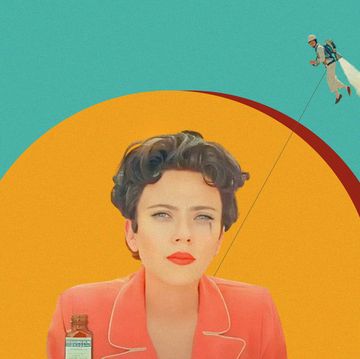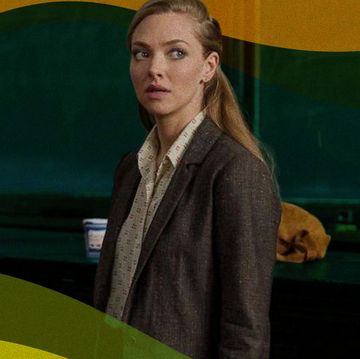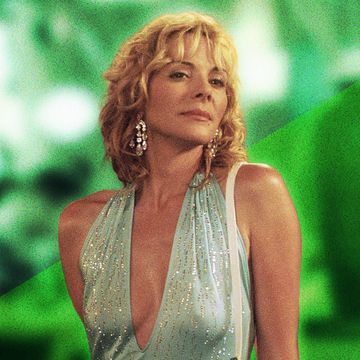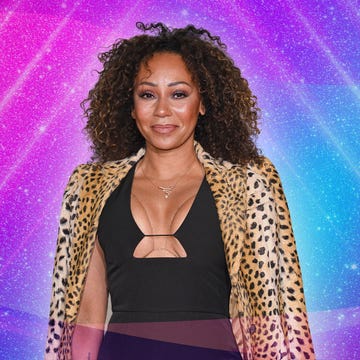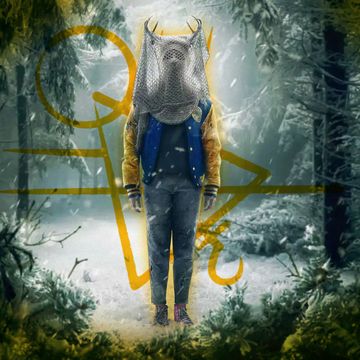Hanging on the wall in my living room, beside a photo of my late grandmother, was a painting that would often leave me transfixed. The piece, which featured a Black man and woman in a loving embrace, felt familiar. Perhaps it was the record player propped upon a green patterned couch that mirrored the very one the painting hung over in our home or the man’s hat positioned in a way my father’s would be on any given warm day.
Maybe it was the way the colors — a vibrant red side table, the deep-blue carpet speckled with black spots — seemed to mimic the fabulous and funky party rooms of my Midwest relatives or how I’d seen aunts, uncles, and neighbors in the same exact pose as this couple throughout my life. Whatever the appeal, Jacob Lawrence’s Lovers resonated with something deep inside of me. Here was art living with me that reflected the lives of those around me.
The first time that I saw the work of Detroit-born figurative painter Mario Moore, that familiar feeling came rushing back in. His paintings open the door, let you in, and place you at the head of the table of a beautiful feast of realism. Moore’s subjects — often blue-collar workers and “ordinary” people — are presented with the dignity bestowed upon royals. He depicts our bodies in space as, at once, worthy as well as free, proving his figures are deserving of their places behind an easel and on museum walls.
A Yale graduate, Princeton University Hodder Fellow, and Duke University artist in residence, Moore is poised to be one of the most poignant Black artists of our generation. The 34-year-old, whose first solo exhibit, “Mario Moore: Enshrined: Presence + Preservation,” is showing at the California African American Museum in Los Angeles, uses his gift to remind the historically white art world that the richness of Black culture is as valuable as any other. And as far as Blackness itself, well, the very act of preserving the everyday regality of our existence in the way his work does makes Moore both painter and savior — and his admirers a willing hallelujah chorus.
Shondaland caught up with Moore to talk about the artistic process, inspiration, and not being limited by success.
IMAN N. MILNER: Tell me about your journey to this point because, correct me if I am wrong, your trajectory has been a bit unusual, in a very good way.
MARIO MOORE: Art for me started with my mom. Her being an artist, I always had art all around me. Specifically growing up around the College for Creative Studies in Detroit, Michigan, where my mom went to school. From a very young age, I was in the classroom with her, and that was where my love for art was first fostered. After high school, I decided to stay in Detroit and go to CCS, but I went the illustrator route because, in my mind, I thought I may do comic books or design book covers — the goal was to ensure that I could make money. After doing the commercial jobs, I was over it.
From there, I started working in the film industry in Michigan. I got a job as a set sculptor. That was another moment where all of my time was going somewhere other than my own work. I wanted to refocus, so I decided to go to grad school, and I ended up at Yale. Once I graduated, the natural move felt like it should be going to New York. And New York is all about hustle. Money is jumping out of your pockets, and everyone is trying to make it. I was working about three jobs, but the one thing that stayed in my mind was that I had to continue to make my own work. I would get off work, and my studio, at the time, was my bedroom, and I would just create from 6 p.m. to whatever time I could manage. Or on the weekends, if I could. That kind of grind and commitment pushed me forward to get bigger opportunities.
INM: Can you explain what made you interested in portraiture and more generally, painting?
MM: It all comes back to my mom because some of her early work was doing these large paintings. But she also had friends whose studios I’d go into and see what they were making. One time that sticks out to me was a time that my older sister and I were being painted by my mom. We were sitting behind the easel, and my mom was in front of it. When she was painting, we’d be making faces and being silly, but when she looked up, we’d stiffen up and try to get in the exact poses we were in before. What it was was seeing her go to this blank canvas and then turning that into a world that I could understand. This is a person; this is a human.
It was also walking around the Detroit Institute of Arts and going through the European galleries looking at the huge paintings with all the mythological stories. I saw that narrative and storytelling were a really big part of this. When I looked at those paintings, I felt like I was in the midst of something major, and that was always something that I wanted to aim for. When I had a chance to study abroad in Italy, that really blew my mind. All of these paintings that you see in history books, you’re seeing the vastness of them. I knew I wanted to do that because it engages people from all walks of life. People who know nothing about art or art history can approach that kind of world.
INM: Right now, there seems to be interest in Black subjects in contemporary art. Do you feel that’s changed or deepened your approach?
MM: I don’t think it’s changed my work. I think we are in a moment right now, and everyone is hyped about Black art, but Black artists have always been making work. It’s now a thing where more of the world is recognizing it, but it hasn’t changed anything for me — I just keep making [artwork]. I think a lot of the older artists are being “rediscovered,” especially the elder Black abstractionists. They’re looking for the person who was missed by art history. It’s a thing where the majority of the white art world has missed that person, but the Black world has not.
The change is incredible, it’s amazing, but it’s also a danger for young artists, including myself. Because what it does is it creates this hyper-moment, especially in figure work, where young artists are being eaten up by the art market, consumed by what is making money, and it can hinder your growth. It can put your work in a box. If you’re young enough, you may not know how to grow out of that. I always want to challenge myself every time I go into the studio. I don’t want to be informed by the last thing I did just because it was popular.
INM: One of your series that I found most poignant was the work you did as a Hodder Fellow at Princeton University in which you decided to use your time there to connect with the staff, made up mostly of people of color, on campus. Why did you choose to center your paintings around them?
MM: The reality of it is that blue-collar mentality that I grew up around in Detroit. I think about the jobs my father had — he was a security guard, he worked for the city, and now he’s a mail person — he’s always been working. A lot of times, growing up, as my dad committed to being a security guard at the Detroit Institute of Arts, I knew all of the other guards, and I would talk to them. The security guards at museums know so much about the art in the space because they have to guard it. You can ask any of them what you should go see in these art institutions, and they’re honest critics, you know?
When I was at school at CCS, as it’s a predominately white institution, when I wanted to feel a sense of home, I’d talk to the janitors and the cafeteria workers. If I didn’t have enough money to pay for food, they’d hook me up with a free meal. It was that piece of familiarity. And they were cheering you on and wanting to see you be successful. So, when I got the fellowship, I knew that’s the way I wanted to go, and so I moved to the campus. That wasn’t a requirement of the fellowship, but I knew I needed to live amongst them to get a full glimpse of who they are. It was a nerve-racking experience because I had to walk up to them and convince them to be part of this, but everyone was really excited about it.
INM: Your first solo exhibition in Los Angeles, “Mario Moore: Enshrined: Presence + Preservation,” which comes directly after a premiere showing in your hometown of Detroit, marks a pretty significant milestone for an artist your age at this part of your career. How are you feeling about that?
MM: It’s kind of unbelievable. Some people want to call it a retrospective, and that’s a very daunting thing to say because, in my mind, I am too young as an artist to call it that. I see it as a survey show, and to have one of those at 34 years of age, it’s incredible. To look at a body of work that spans 10 years, from 2011 to the present, I am still trying to wrap my head around it. To get that opportunity at any museum, but to have a survey show that goes from one museum to another in a completely different state, I feel an immense sense of pride. One thing I think about when I go to the exhibits and see the work, some of it I haven’t seen in 10 years, and it’s like meeting with an old friend. I can see my journey happening before my eyes. Looking at what kind of work I was making then and how I made it to the things that are more recent — I’m really just honored.
INM: In some of your earlier works, you make yourself a subject in pieces that seem to speak to the complexities of being both Black and male in this country. Was that simply an artist using the canvas to work through his own experiences, or was there something more behind that?
MM: I think it was both. As an artist, I am always thinking about the history of art. Which tradition am I working in, and which ones am I bucking up against? Which conversations am I having? I am also recognizing that my body in that world is something that’s usually excluded, but also my body in this country is something that has been downtrodden, terrorized, demoralized, and criminalized. All of those things come together when I am using myself as a subject. At the same time, I’m just always available [laughs].
INM: There is something magnificent about the way Black artists are able to validate the Black body in spaces where they are not normally accepted or celebrated. Sometimes, though, Black artists can feel confined to making only one type of art. Tell me about honoring that history without feeling bound to it.
MM: As an artist, in general, I am always looking to be just that. In the moment that we’re in right now, we’re putting quotations around Black. It can limit the ideas that can be built. I consider the broader art history while also considering what’s going on in my community. When I go into the studio, I treat it like a science lab. I always want to make sure that I am experimenting and not getting too caught up in what people think is great or what they want to see me make. I try to make sure that I stay excited. If I go into the studio and I feel challenged, then I know I am headed in the right direction and that I am not looking outside of myself at what I think people want me to do.
INM: Every artist draws inspiration from the artists who preceded them, but I am curious if there are Black artists whom you would consider peers whose work pushes you to dive deeper into your own?
MM: For me, the one who is at the top in my circle, her name is Jennifer Packer. The way that the paintings are put together is just so incredible. It is some of the most luscious painting. And what they’re about: Protecting the Black body and how we think about images, it’s truly remarkable work. As far as people who are close to my age, she’s the top for me. A living artist who I just think is a master is Kerry James Marshall. People who I look at who are in that context but have recently passed on would be Barkley Hendricks, the great painter. And someone who is more traditional would be Diego Velázquez.
Iman N. Milner is an actress and writer living and working in Los Angeles. Follow her on Twitter @imannmilner
Get Shondaland directly in your inbox: SUBSCRIBE TODAY


